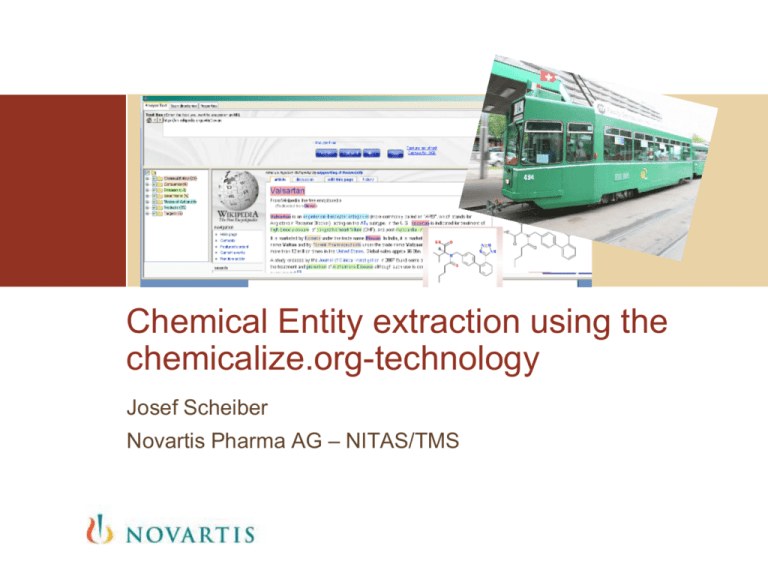- ChemAxon
advertisement

Chemical Entity extraction using the chemicalize.org-technology Josef Scheiber Novartis Pharma AG – NITAS/TMS Where the story of this project started ... A day in October 2008 Some time around 7:45 in the morning ... Novartis Campus Dreirosenbrücke Vision for textmining Integration chemical, biological knowledge Mining for Chemical Knowledge - Rationale - Make text corpora searchable for chemistry - Generate chemistry databases for use in research based on Scientific Papers or Patents - Link Chemical Information with further annotation in an automated way for e.g. Chemogenomics applications - Patent analyis for MedChem projects Connection table Mining for chemical Knowledge - Rationale Information on compounds targeting GPCRs HELP Information explosion Source: Banville, Debra L. “Mining chemical structural information from the drug literature.” Drug Discovery Today, Number 1/2 Jan. 2006, p.35-42 Example: Project Prospect – Royal Society of Chemistry Enhancing Journal Articles with Chemical Features This helps you identifying other articles talking about the same molecule Mining for Chemical Knowledge – Focus for today - Make text corpora searchable for chemistry - Generate chemistry databases for use in research based on Scientific Papers or Patents - Link Chemical Information with further annotation in an automated way for e.g. Chemogenomics applications - Patent analyis for MedChem projects Connection table A use case for successful patent mining (molecules you sometimes find in your inbox ;-) ) Sildenafil (1998, Pfizer) – € 11.7 billion (USD 15.1 billion) Slide inspired by an example from Steve Boyer/IBM; Sales data from Prous Integrity datase Vardenafil (2003, Bayer) – € 1.24 billion (USD 1.6 billion) Conventional Database Building Facts – current standard ... (ACS) owes most of its wealth to its two 'information services' divisions — the publications arm and the Chemical Abstracts Service (CAS), a rich database of chemical information and literature. Together, in 2004, these divisions made about $340 million — 82% of the society's revenue — and accounted for $300 million (74%) of its expenditure. Over the past five years, the society has seen its revenue and expenditure grow steadily ... Source: ACS homepage Facts Established application Straighforward use De-facto Gold standard Unique data source Very costly No structure export for reasonable price Very limited in large-scale follow-up analysis Most recent patents not available Not data (search), but integration, analysis and insight, leading to decisions and discovery Now – What would be the perfect solution? All patent offices require to provide all claimed structures as machine-readable version available for one-clickdownload Text extraction Definition: Extract all molecules that are mentioned in a patent text of interest, convert them to structures and make them available in machine-readable format Mining for Chemical Knowledge Technologies from providers Text entity recognition Image recognition (a) Extractors (IUPAC names) - TEMIS Chemical Entity Relationships Skill Cartridge - Accelrys Pipeline Pilot extractor (Notiora) - Fraunhofer (ProMiner Chemistry) - Chemaxon (chemicalize.org) - Oscar (Corbett, Murray-Rust et al.) - SureChem - IBM ChemFrag Annotator - OSRA (NIH) (b) Converter (Names connection table) - CambridgeSoft name=struct - Openeye Lexichem - Chemaxon - Clide Pro (Keymodule Ltd.) - Fraunhofer chemoCR - ChemReader The objective To provide a tool that provides sophisticated text analysis methods for NIBR scientists and thereby leverages the methods of TMS Mining for Chemical Knowledge – Novartis Tools – the chemicalize-technology is working under the hood! Clipboard Analysis Identified structures Patent text View structure onMouseOver Export to other applications Mining for Knowledge – Novartis Tools Input example: J Med Chem Paper Mining for Chemical Knowledge – Use Case Medicinal Chemist wants to synthesize competitor compound as tool compound for own project This enables the identification of compounds most representative for a Identification competitor patent of core scaffold Analysis of substitution patterns Example – A text-based patent A patent example Automated Text extraction 452 compounds Reference 636 compounds 71% Example – An image-base patent Text extraction not suitable for this case, it does find only a meager 40 molecules, 1129 in reference – Why? An entirely image-based patent example Language issues – e.g. Japanese patents Encountered problems OCR (Optical Character Recognition)!! USPTO and WIPO are now available full text in most cases Typos! Name2Struct problems (less an issue here) IBM initiative Patent Mining / ChemVerse database (Steve Boyer) The objective is to automatically extract all molecules from all patents available and make them searchable in a database They leverage cloud computing and have access to all fulltext patents This is going absolutely the right direction They annotate the molecules with information from freely available databases Future ideas: Patent Analysis Markush translation, Image+Target Ranking capabilities of outcome for User „blurred“ dicos for translating stuff like aryl, cycloalkyl etc. Select annotate as entity on the fly error-correction Result goes in a database Crowdsourcing efforts to improve and store results Suggest functionality To enable true Patinformatics analyses ... Definition by Tony Trippe: Acknowledgements NITAS/TMS Therese Vachon Daniel Cronenberger Pierre Parisot Martin Romacker Nicolas Grandjean Alex Fromm Katia Vella Olivier Kreim Clayton Springer Naeem Yusuff Bharat Lagu And many other people in different divisions of NIBR for their support



